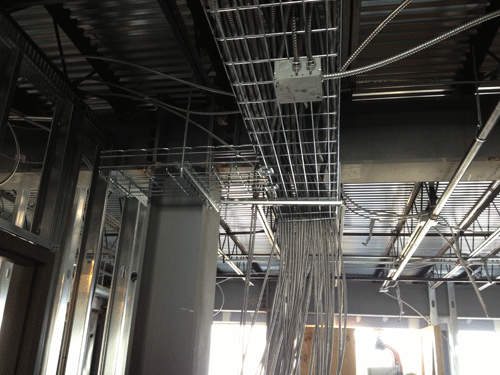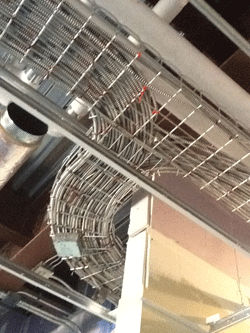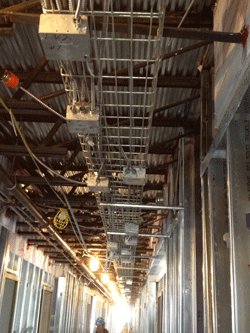
Building construction has failed to keep pace with productivity improvements found in other segments of the economy. According to the U.S. Bureau of Labor Statistics, nonfarm (manufacturing) productivity has improved 200 percent since 1964 while construction productivity has actually declined. Studies also indicate that only about one-third of the working day is physical, hands-on installation and testing. The rest is overhead activities associated with installation or nonproductive time such as breaks, cell phone use, and so forth. Whatever the causes of lost or unproductive time, electrical contractors must identify new methods that will improve productivity and remove impediments to success.
As an alternative to traditional conduit, one of the best and most innovative methods is to adopt the practice of installing metal clad (MC) cable in wire mesh cable management systems in branch and feeder circuits.
Compared to conduit, wire mesh cable management requires fewer parts and tools. It adapts to the most complex configurations, and its structure gives maximum strength for minimum weight. The ease of creating fittings onsite, as well as the wide range of accessories, gives complete freedom in routing. An electrical infrastructure built this way is fast, flexible, scalable, and sustainable.
Open Wire Management
Wire mesh cable management must be primarily understood not as a wiring method but instead as a mechanical support for other wiring methods. This concept is addressed in the definition of the subject as found in the National Electrical Code (NEC) 392.2:
“Cable Tray System. A unit or assembly of units or sections and associated fittings forming a structural system used to securely fasten or support cables and raceways.” Thus, wire mesh cable management is defined as a structural system that fastens or supports cables or raceways. In overhead locations, on walls, and underfloor, wire mesh cable management is a neat and orderly, UL-approved support for MC cable.
Wire mesh cable management is a simple system to design, specify, and install. Unfortunately, it suffers from the misconception that this form of cable tray requires that the design and specification documentation include every part and piece. In fact, this is not true because wire mesh is highly configurable in the field. This system does not require special pieces to make corners, Ts, up/down angles, or intersections. Installers simply make the necessary cuts to the mesh for any desired configuration. Therefore, while the pathway is indicated, individual parts need not be shown.
Advantages of Open Systems

Electrical contractors can save time installing MC cable in wire mesh cable management compared to using standard wiring in electrical metallic tubing (EMT) conduit. A study of sample installations comparing the two found a savings of up to 30 percent using wire mesh cable management and MC cable instead of conduit.
Compared to conduit, wire mesh requires fewer parts, no preformed fittings, and fewer tools. One person can do the entire job quickly using a bolt cutter. In contrast, conduit must be carefully measured to determine the correct angle of bend using specialized bending equipment. Pipes must then be assembled and secured in place.
The ease of creating fittings carried out onsite, as well as the wide range of unique and universal accessories gives complete freedom in routing combined with exceptionally fast installation. Cable management is one of the last considerations in the design and construction phases of a project. Therefore, a solution is required that will allow planning around other building systems despite not knowing their final destinations and elevations. Wire mesh cable management allows design of a cable-tray system to take place earlier because contractors have the flexibility to make simple field changes without a change order.
In addition, there is no need to provide a parts list of special pieces. This system provides ease of bidding and purchases for contractors and also limits the number of part numbers for an engineer to specify.
Cost Considerations

The cost of EMT conduit materials are approximately 30 percent higher than wire mesh, and the labor costs are two and a half times as much. Contractors use less time for installation, therefore saving time and money. Further, a shortage of skilled pipe benders impedes the ability to deliver electrical infrastructure quickly and profitably. Contractors gain additional financial advantages due to lower training requirements for wire mesh installation and the fact that components can be more easily prefabricated offsite. The savings go to the contractor because it’s a value-engineered alternative to labor-intensive conduit.
Converting branch circuits to MC cable in wire mesh can save 20 to 50 percent in installation time over pipe and wire. Even projects already allowing MC cable in the branch circuits will see productivity improvements by introducing wire mesh pathways. Combining a wire mesh grid with branch circuit distribution boxes mounted directly to the tray creates a “plug-and-play” type system that installs quickly and permits cables to be pulled or laid in place. Even after a system is completely installed, the flexibility of MC cable in wire mesh offers advantages, including making moves, adds, and changes more quickly and efficiently.
Additional advantages of installing MC cable in wire mesh cable management include reducing or eliminating unproductive jobsite activities. This system also has the potential to eliminate hot work in industrial environments. Unlike conduit, MC cable and wire mesh do not carry the risk of trapping moisture or transporting gases; important considerations in many industrial environments. Conductors installed within conduit cannot dissipate heat as readily as those installed in open wiring, so the current capacity of each conductor must be reduced if many are installed in one conduit. Wire mesh allows heat to dissipate. Also, when installed and grounded correctly, wire mesh cable management significantly reduces electromagnetic disturbances. The steel structure of the tray absorbs electromagnetic interference and drains the disturbance away from cables causing minimal effect to the connected equipment.
Conclusion
Moving from conduit into MC cable and wire mesh cable management is a significant step to higher productivity and profitability. The results extend beyond lower purchasing prices on materials and improved labor costs. It’s all about managing and controlling risk and improving the ability to meet aggressive schedules while remaining viable, competitive, and profitable contracting organizations.
Is anyone here in a position to recommend Erotic Chocolate Body Paint? Thanks xox